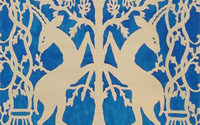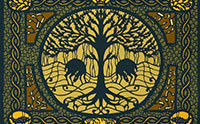Yehudit Shadur

Yehu dit Shadur (1928-2011) grew up in Milwaukee, WI and studied fine art and art history in Milwaukee, London, and New York. In 1950, she settled in Israel, first on kibbutz Nirim in the Negev and later in Jerusalem. For several years she lived and taught at the Sdeh Boqer College of the Negev. Besides her work based on traditional Jewish folk art, she exhibited landscape drawings and has worked in various print-making techniques, mural compositions, and Jewish decorative arts. Yehudit Shadur pioneered the contemporary revival of the Jewish papercutting tradition. She made her first papercut mizrah in 1966 for the 80th birthday celebration of David Ben Gurion, Israel’s first prime minister. Taken by the medium, she immersed herself in the ancient symbols of the East European tradition of Jewish Papercuts: the menorah, the tree of life, lions, deer, crowns, vines, and Hebrew calligraphic inscriptions. To these, she added new motifs and innovations including images of the walled city of Jerusalem, columns, natural imagery, colored layers, embellishments and asymmetry taking a traditional devotional medium and making it her own.
dit Shadur (1928-2011) grew up in Milwaukee, WI and studied fine art and art history in Milwaukee, London, and New York. In 1950, she settled in Israel, first on kibbutz Nirim in the Negev and later in Jerusalem. For several years she lived and taught at the Sdeh Boqer College of the Negev. Besides her work based on traditional Jewish folk art, she exhibited landscape drawings and has worked in various print-making techniques, mural compositions, and Jewish decorative arts. Yehudit Shadur pioneered the contemporary revival of the Jewish papercutting tradition. She made her first papercut mizrah in 1966 for the 80th birthday celebration of David Ben Gurion, Israel’s first prime minister. Taken by the medium, she immersed herself in the ancient symbols of the East European tradition of Jewish Papercuts: the menorah, the tree of life, lions, deer, crowns, vines, and Hebrew calligraphic inscriptions. To these, she added new motifs and innovations including images of the walled city of Jerusalem, columns, natural imagery, colored layers, embellishments and asymmetry taking a traditional devotional medium and making it her own.
Yehudit and her husband, Joseph Shadur, wrote two illustrated books on Jewish papercuts: Traditional Jewish Papercuts: An Inner World of Art and Symbol, 2002, the definitive work on the subject, and Jewish Papercuts: A History and Guide, which won the National Jewish Book Council Award in 1994.
Her papercuts have been acquired by the Israel Museum; the Smithsonian Institution; the U.S. Library of Congress; the Jerusalem City Museum; the Wolfson Museum – Hechal Shlomo, Jerusalem; the Haifa Museum of Ethnology; the American Cultural Center, Tel Aviv; Mishkan le’Omanut Ein Harod; The Jewish Museum in New York; the Spertus Museum in Chicago; the Magnus Museum, Berkeley, and many other private and public collections.

